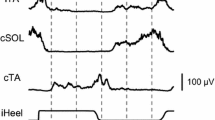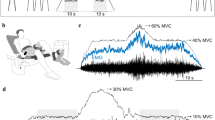Summary
Phase-dependent reflex modulation was studied by recording the electromyographic (EMG) responses in ankle flexors (Tibialis Anterior, TA) and extensors (Gastrocnemius Medialis, GM and Soleus, SOL) to a 20 ms train of electrical pulses, applied to the tibial or sural nerve at the ankle, in human volunteers walking on a treadmill at 4 km/h. For low intensity stimuli (i.e. 1.6 times perception threshold), given during the swing phase, the most common response was a suppression of the TA activity with a latency of 67 to 118 ms. With high intensity of stimulation (i.e. 2.8 × T), a facilitatory response appeared in TA with a latency of 74 ms. This latter response was largest during the middle of the swing phase, when it was correlated with exaggerated ankle dorsiflexion. The TA reflex amplitude was not a simple function of the level of spontaneous ongoing activity. During stance, TA responses were small or absent and accompanied by a suppression of the GM activity with a latency ranging from 62 to 101 ms. A few subjects showed an early facilitatory, instead of a suppressive, GM response (88 to 136 ms latency). They showed a phase-dependent reflex reversal from a dominant TA response during swing to a facilitatory GM response with an equivalent latency during stance. The GM facilitation occurred exclusively during the early stance phase and habituated more than the TA responses. It is concluded that phase-dependent gating of reflexes occurs in ankle muscles of man, but only when vigorous extensor reflexes are present. More commonly, a phase-dependent modulation is seen, both of facilitatory and suppressive responses.
Similar content being viewed by others
References
Abraham LD, Marks WB, Loeb GE (1985) The distal hindlimb musculature of the cat. Exp Brain Res 58: 594–603
Andersson O, Forssberg S, Grillner S, Lindquist M (1978) Phasic gain control of the transmission in cutaneous reflex pathways to motoneurones during “fictive” locomotion. Brain Res 149: 503–507
Ashby P, Hilton-Brown P, Stalberg E (1986) Afferent projections to human tibialis anterior motor units active at various levels of muscle contraction. Acta Physiol Scand 127: 523–532
Bayev KV (1981) Retuning of segmental responses to peripheral stimulation in cats during fictitious locomotion. Neurophysiol (Kiev) 13: 206–212
Becker WJ, Hayashi R, Lee RG, White D (1987) Effect of cutaneous nerve stimulation on voluntary and stretch reflex electromyographic activity in wrist flexors in humans. J Physiol 382: 509–522
Belanger M, Patla AE (1984) Corrective responses to perturbation applied during walking in humans. Neurosci Lett 49: 291–295
Berger W, Dietz V, Quintern J (1984) Corrective reactions to stumbling in man: neuronal co-ordination of bilateral leg muscle activity during gait. J Physiol 357: 109–125
Caccia MR, McComas AJ, Upton ARM, Blogg T (1973) Cutaneous reflexes in small muscles of the hand. J Neurol Neurosurg Psychiat 36: 96–977
Capaday C, Stein RB (1986) Amplitude modulation of the soleus Hreflex in the human during walking and standing. J Neurosci 6: 1308–1313
Creed RS, Denny-Brown D, Eccles JC, Liddell EGT, Sherrington CS (1932) Reflex activity of the spinal cord. University Press, Oxford
Crenna P, Frigo C (1984) Evidence of phase-dependent nociceptive reflexes during locomotion in man. Exp Neurol 85: 336–345
Crenna P, Frigo C (1987) Excitability of the soleus H-reflex arc during walking and stepping in man. Exp Brain Res 66: 49–60
Delwaide PJ, Crenna P (1981) Cutaneous nerve stimulation and motoneurone excitability. I. Soleus and tibialis anterior excitability after ipsilateral and contralateral sural nerve stimulation. J Neurol Neurosurg Psychiat 44: 699–707
Delwaide PJ, Crenna P (1984) Cutaneous nerve stimulation and motoneurone excitability. II. Evidence for non-segmental influences. J Neurol Neurosurg Psychiat 47: 190–196
Dietz V, Quintern J, Berger W (1985) Afferent control of human stance and gait: evidence for blocking of group I afferents during gait. Exp Brain Res 61: 153–163
Dietz V, Quintern J, Boos G, Berger W (1986) Obstruction of the swing phase during gait: phase-dependent bilateral leg muscle coordination. Brain Res 384: 166–169
Dietz V, Berger W, Quintern J (1987) Task-dependent gating of somatosensory transmission in two different motor tasks in man: falling and writing. Neurosci Lett 75: 288–292
Drew T and Rossignol S, (1985) Forelimb responses to cutaneous nerve stimulation during locomotion in intact cats. Brain Res 329: 323–328
Dubuc R, Cabelguen J.-M, Rossignol S (1988) Rhythmic fluctuations of dorsal root potentials and antidromic discharges of primary afferents during fictive locomotion in the cat. J Neurophysiol 60: 2014–2036
Duenas SH, Rudomin P (1988) Excitability changes of ankle extensor group Ia and Ib fibers during fictive locomotion in the cat. Exp Brain Res 70: 15–25
Duysens J (1977) Reflex control of locomotion as revealed by stimulation of cutaneous afferents in spontaneously walking premammillary cats. J Neurophysiol 40: 737–751
Duysens J, Pearson KG (1976) The role of cutaneous afferents from the distal hindlimb in the regulation of the step cycle of thalamic cats. Exp Brain Res 24: 245–255
Duysens J, Loeb GE (1980) Modulation of ipsi- and contralateral reflex responses in unrestrained walking cats. J Neurophysiol 44: 1024–1037
Duysens J, Loeb GE, Weston BJ (1980) Crossed flexor reflex responses and their reversal in freely walking cats. Brain Res 197: 538–542
Duysens J, Stein RB (1978) Reflexes induced by nerve stimulation in walking cats with implanted cuff electrodes. Exp Brain Res 32: 213–224
Forssberg H (1979) Stumbling corrective reaction: a phase-dependent compensatory reaction during locomotion. J Neurophysiol 42: 936–953
Forssberg H, Grillner S, Rossignol S (1975) Phase dependent reflex reversal during walking in chronic spinal cats. Brain Res 85: 103–107
Garrett M, Ireland A, Luckwill RG (1984) Changes in excitability of the Hoffmann reflex during walking in man. J Physiol (London) 355: 23 P
Grillner S (1981) Control of locomotion in bipedes, tetrapods, and fish. In: Brooks VB (ed) Handbook of physiology, Sect I. The nervous system. II. Motor control, Part 2. American Physiological Society, Bethesda, MD, pp 1179–1236
Hugon M (1973) Exteroceptive reflexes to stimulation of the sural nerve in normal man. In: Desmedt JE (ed) New developments in electromyography and clinical neurophysiology, Vol 3. Karger, Basel, pp 713–729
Kanda K, Sato H (1983) Reflex responses of human thigh muscles to non-noxious sural stimulation during stepping. Brain Res 288: 378–380
La Bella LA, Kehler JP, McCrea DA (1989) A differential synaptic input to the motor nuclei of triceps surae from the caudal and lateral cutaneous sural nerves. J Neurophysiol 61: 291–297
Meinck HM, Benecke R, Küster S, Conrad B (1983) Cutaneomuscular (flexor) reflex organization in normal man and in patients with motor disorders. In: Desmedt JE (ed) Motor control mechanisms in health and disease. Raven Press New York, pp 787–789
Miller S, Ruit JB, van der Meche FGA (1977) Reversal of sign of long spinal reflexes dependent on the phase of the step cycle in the high decerebrate cat. Brain Res 128: 447–459
Morin C, Katz R, Mazieres L, Pierrot-Deseilligny E (1982) Comparison of soleus H-reflex facilitation at the onset of soleus contractions produced voluntarily and during the stance phase of human gait. Neurosci Lett 33: 47–53
Orsal D, Perret C, Cabelguen JM (1986) Evidence of rhythmic inhibitory synaptic influences in hindlimb motoneurons during fictive locomotion in the thalamic cat. Exp Brain Res 64: 217–224
Patla AE, Belanger M (1983) Modulation of the response to a nociceptive stimulus during walking in humans. Soc Neurosci Abstr 9: 617
Perret C, Cabelguen JM (1980) Main characteristics of the hindlimb locomotor cycle in the decorticate cat with special reference to bifunctional muscles. Brain Res 187: 333–352
Rossignol, S (1975) Startle responses recorded in the leg of man. Electroencephalogr Clin Neurophysiol 39: 389–39
Rossignol S, Drew T, (1986) Phasic modulation of reflexes during rhythmic activity. In: Grillner S, Forssberg H, Stein PSG, Stuart D (eds) Neurobiology of vertebrate locomotion. Int symp series 45. MacMillan, London, pp 517–534
Schmidt BJD, Meyers ER, Tokuriki M Burke RE (1989) Modulation of short latency cutaneous excitation in flexor and extensor motoneurons during fictive locomotion in the cat. Exp Brain Res 77: 57–68
Schomburg ED, Roesler M, Meinck HM (1977) Phase-dependent transmission in the excitatory propriospinal reflex pathways from forelimb afferents to lumbar motoneurones during fictive locomotion. Neurosci Lett 4: 249–259
Sillar KT, Roberts A (1988) A neuronal mechanism for sensory gating during locomotion in a vertebrate. Nature 331: 262–265
Stein RB, Capaday C (1988) The modulation of human reflexes during functional motor tasks. Trends Neurosci 11: 328–332
Wand P, Prochazka A, Sontag KH (1980) Neuromuscular responses to gait perturbations freely moving cats. Exp Brain Res 38: 109–114
Author information
Authors and Affiliations
Rights and permissions
About this article
Cite this article
Duysens, J., Trippel, M., Horstmann, G.A. et al. Gating and reversal of reflexes in ankle muscles during human walking. Exp Brain Res 82, 351–358 (1990). https://doi.org/10.1007/BF00231254
Received:
Accepted:
Issue Date:
DOI: https://doi.org/10.1007/BF00231254




